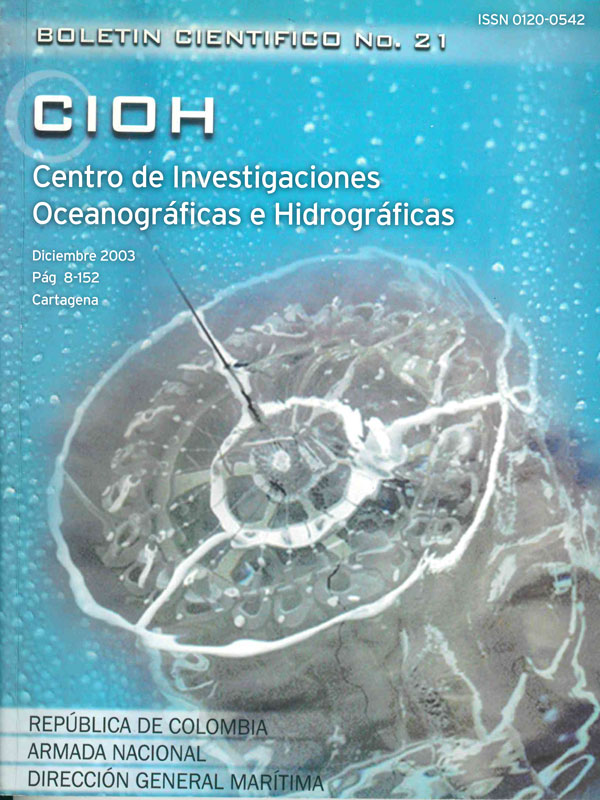Sistema de pronóstico de las condiciones oceanográficas del Mar Caribe
DOI:
https://doi.org/10.26640/22159045.112Palabras clave:
Mar Caribe, modelo hidrodinámico, pronóstico oceanográfico, derrame de hidrocarburoResumen
Se presenta un sistema de pronóstico de los parámetros oceanográficos basado en un modelo hidrodinámico para el mar caribe. El sistema recibe información en tiempo cuasi-real sobre la temperatura superficial del mar procedente de satélites de la NOAA, para ser asimilada; adicionalmente, recibe datos de viento del modelo global meteorológico de alta resolución, UKMO (United Kingdom Meteorological Office), los cuales se utilizan como entradas diarias para realizar pronósticos hasta de 72 horas. El sistema está en capacidad de pronosticar el movimiento de una mancha de hidrocarburo derramada y la trayectoria de un artefacto flotante a la deriva; suministra información útil a las unidades de guerra sobre la estructura térmica de la columna de agua y puede tener aplicaciones en la pesquería, entre otras. Se describe el funcionamiento del sistema en el régimen de operación diaria, en caso de un accidente y cuando se requiere re-inicializar el modelo (régimen de falla).
Se describen en detalle la información de entrada al modelo, la formulación del bloque de transporte, y el software amigable que permite su operación.
Descargas
Referencias
Da Silva, A.M. & Levitus, S. (1994). Atlas of Surface Marine Data 1994, NOAA, Wash., D.C.
Estrada, H. (1995). Programa para la predicción acústica submarina PROPAS 1.0, CIOH.
Kazakov, A.L., A.A. Lezhenin y L.S. Speranskiy, (1996). Resultados Preliminares del Estudio de la Capa Limite Mesometeorológica de la Atmósfera en la Costa Norte Colombiana Aplicando un Modelo Numérico, Boletín Científico CIOH, N. 17, pp. 17-26.
Levitus, S. (2001). World Ocean Atlas 2001, NOAA Atlas NESDIS 54, Silver Spring, MD.
Lonin, S.A., (1997). Guía para usuarios de un modelo acoplado océano y atmósfera para la plataforma Caribe colombiana. Versión 1.0., CIOH, Febrero de 1997.
Lonin, S.A., (1999). Lagrangean Model for Oil Spill Diffusion at Sea. Spill Science & Teclmology Bulletin, Vol. 5, No. 5/6, pp. 331- 336.
Lonin, S.A., (2001). Informe actividades del año 2001. CIOH. Informe final DIMAR.
Lonin S., Anduckia J., Parra C., Molares, R. (2003). Modelo de circulación oceánica con asimilación de datos para el Caribe aplicado en derrame de hidrocarburos, pesquería y búsqueda y rescate, Memorias del seminario nacional de Ciencias del Mar, Santa Marta, abril de 2003.
Lozano, C.J., Robinson, A.R., Arango, H.G., Gangopadhyay, A., Sloan, Q., Haley, P.J., Anderson, L. & Leslie, W. (1996). An Interdisciplinary Ocean Prediction System: Assimilation Strategies and Structured Data Mcdels. In: Modern Approaches to Data Assimilation in Ocean Modeling, edited by P. Malanotte-Rizzoli, Elsevier Sci., pp. 413-452.
Mackay, D., Buist, I., Mascarenhas, R. & Petersen, S., (1980). Oil Spill Processes and Models. Environmental Protection Service, Canada, Report EE-8.
Manual OMI de Búsqueda y Salvamento, (1987). Organización Marítima Internacional, Londres, 192 p.
Matveev, L.T. (1984). The Course of General Meteorology (Physics of Atmosphere). Leningrad, Gidrometeoizdat.
Mellor, G.L. (1993). User's Guide for a Three- Dimensional Primitive Equation Numerical Ocean Model, Princeton, NJ, 35 p.
Monin, A. S. & Yaglom, A.M., (1971). Statistical Fluid Mechanics. Vol. 1, IVLIT Press, Cambridge, 696p.
Descargas
Publicado
Número
Sección
Licencia
Reconocimiento — Debe reconocer adecuadamente la autoría, proporcionar un enlace a la licencia e indicar si se han realizado cambios<. Puede hacerlo de cualquier manera razonable, pero no de una manera que sugiera que tiene el apoyo del licenciador o lo recibe por el uso que hace.
NoComercial — No puede utilizar el material para una finalidad comercial.
SinObraDerivada — Si remezcla, transforma o crea a partir del material, no puede difundir el material modificado.
No hay restricciones adicionales — No puede aplicar términos legales o medidas tecnológicas que legalmente restrinjan realizar aquello que la licencia permite.



